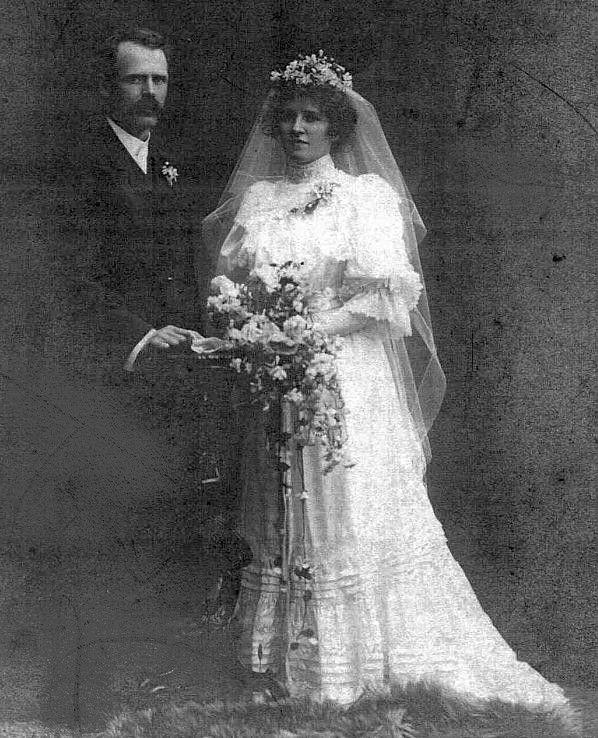








Walter Guildford was b: 30 Dec 1884 in Pleasant Valley, Geraldine and d: 27 Mar 1918 WW1 in France Bur: Anchonvillers Military Camp, France (PDF) It is uncertain if the 18 year old Walter accompanied his parents and family to Tarata in 1902, but between 1905 and 1911 he was employed as a farmhand at Pleasant Valley before helping brother William on the farm at Tarata and just prior the war, he was farming at Temuka.1910 - Ashburton Guardian, 20 September 1910: The formalities in connection with the purchase of Mr Brookland's farm at Winchester under the Land Settlement Finance Act, 1909, are now completed, says Mr Buxton, M.P. This is the first purchase in the South Island under this Act. The area purchased is about 400 acres and the Association consists of S. W. Trumper, junior, W. Guilford, W. T. Bill, Arthur Davey, and George Duke. WW1 - Walter Guilford; Nominal Roll Vol.2; Regimental No 21820; Rank Rifleman; Next of Kin - Mrs J Guilford; wife; C% H Ferguson, 84 Sherborne St, St Albans, Christchurch; Roll 38; Page 34;
Walter's marriage to Jean Helen Love took place 17th April, 1916 at Dunedin and was recorded at the Dunedin Registry Office. Sister, Jeanette Love was a witness. Two days later, Walter was best man at his brother Robert's wedding at Temuka. Jean was living at Sherborne Street, St Albans in Christchurch when Walter commenced his army service on May 3rd. Army details Height 5 ft 10"; Weight 180 lbs; Religion Methodist; Eyes blue; He received the required vaccinations prior to departure August and early September 1916 with the 16th Reinforcement. Walter's practical skills were utilised on arrival in Europe - between 8th January 1917 and the 9th March, he was attached to the railway construction gang and then rejoined the Battalion. On April 5th he was attached to the 2nd Anzac burying party - the grimmest duties of the war was to bury one's comrades. Life was spent in trenches, existing in what was often a lice-ridden, rat infested hole in the ground waiting for a stray shell or sniper's bullet to take its toll. Routines involved "stand to arms" inspections, cleaning of rifles, repairing the barbed wire of the entanglements which lay between the frontline and No Man's land - an area that ranged from 20 metres to over 800 metres across and stretched 720 kilometres from the Belgium coast to the Swiss frontier. Daylight raids were carefully planned dashes across No Man's Land after a short artillery and mortar barrage and night raids slow and secretive. Casualties were high among New Zealand soldiers who built an impressive reputation of dependability to perform under all conditions. Walter was hospitalised and rejoined the Battalion 15/5/1917 and in the beginning of October, he was moved to 2nd Arm Reg. Comb. On the 24th February 1918, the New Zealanders moved away from the front for a long overdue spell of rest and retraining in the St Marie Cappel area, 40 kilometres to the rear. Three months in the front line over a harsh winter, after six months of bitter fighting had left , everyone exhausted. So, for most of March 1918, the New Zealand division rested and trained in the Etaples area. The combined effect of rest and
exercise was a boost to their physical condition and boosted morale. There
were hints that an expected new German offensive was inevitable. The war
had been going badly for Germany, and now with some troops arriving from
the United States, action must be taken before significant numbers
followed. It was their last chance to inflict a crushing defeat on the
Allies. 21st March,19l8, the German forces
attacked along a 80 kilometre front from St Quentin in the south to Arras
in the north. Here the British 3rd and Sth Armies encountered the main
thrust and were outnumbered four to one and started to buckle and fall
back. The situation became desperate - the Sth Army was smashed and the
line was in tatters. In the south, New Zealand had joined the Australian
3rd, 4th and Sth divisions and 32nd Division there was now only tenuous
contact with the French and in the north, the army was in retreat. This
left the way open for the Germans to break through in strength, and split
the British and French Armies. This would force the British to pull back
to the north to maintain access to Channel ports while the French would
need to move south to block the approaches to Paris.
The New Zealanders had to close the gap
by establishing a line between the villages of Hamel and a distance of
over 4 kilometres. In this offensive,
Walter Guilford lost his life on March
23rd.
Record of
service Attached Railway
construction gang Rejoined Battalion from
Railway construction party Attached 2nd
Anzac Caple Burying party Attached to Working
Battalion 24.4.1917 Rejoined Battalion from
hospital Moved to 2nd
Army Reg Comb Killed in
Action Buried Anchonvillers
Military Camp 4 L 57 a.q. 9a
3 Rev R J Watson Plot 1 Row
1 Grave No 33 |